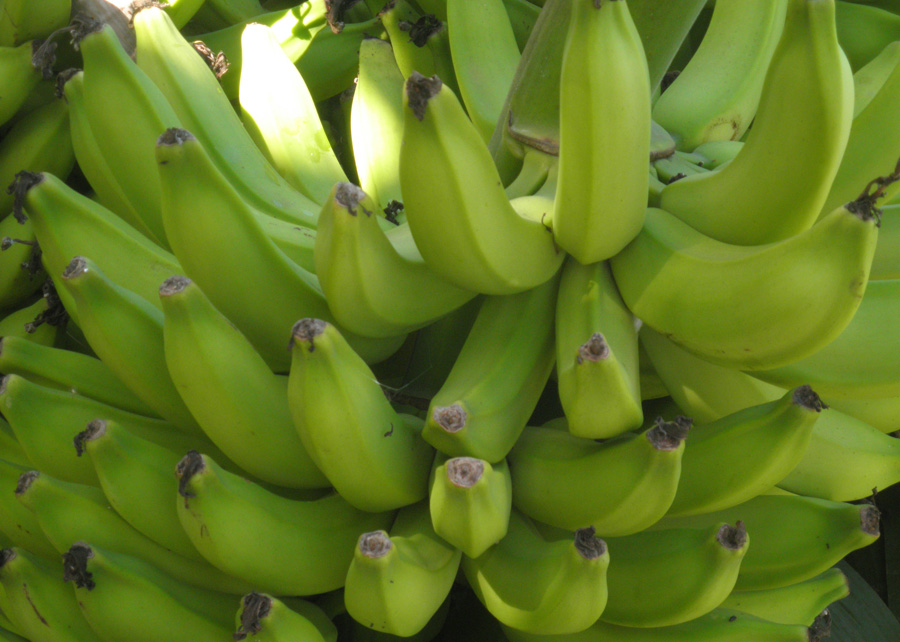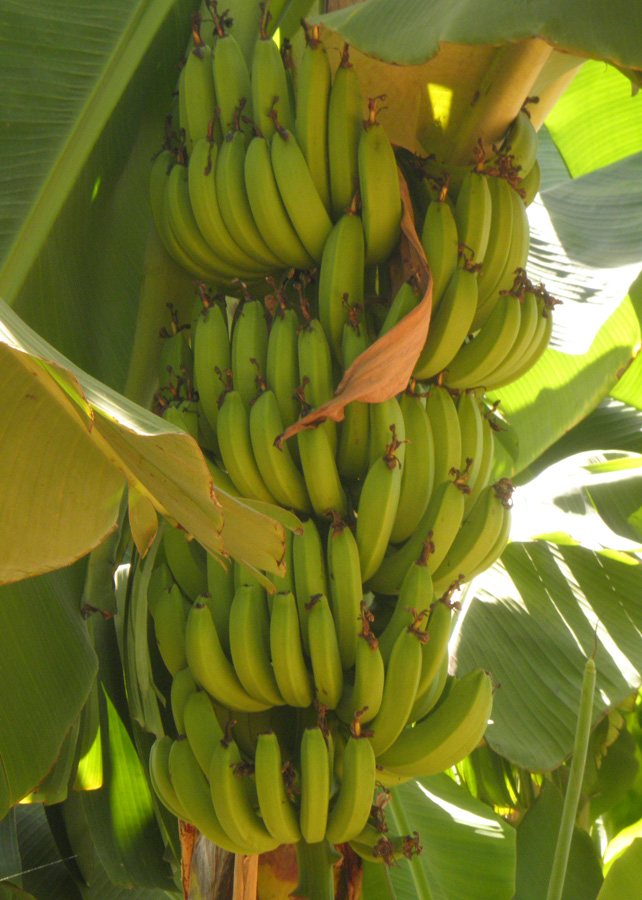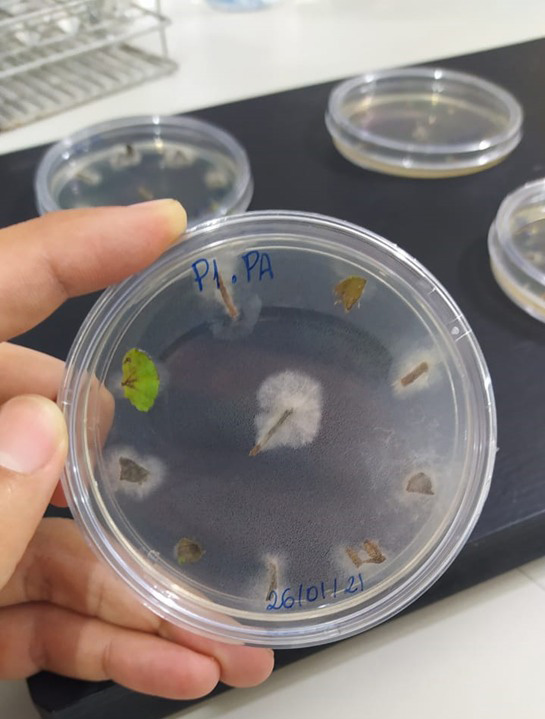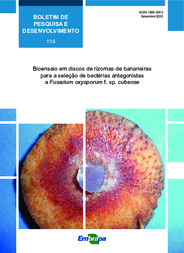Study in São Paulo, Brazil, found that cover plants are potential hosts of the fungi that cause fusariosis in banana. Popularly known as Panama disease, it is the worst banana disease in the world, and it is capable of causing losses of up to 100% in banana plantations. In recent decades, it has been called the 'banana pandemic' since tropical landrace 4, which has not occurred in Brazil yet, has already reached more than 20 countries. The discovery sets a new precedent for the management of plants in the field in order to contain the spread of the pathogen. Current management does not consider alternative hosts such as cover plants. Banana is grown in all Brazilian states, but diseases are a limiting factor to the activity's growth in the country. Research developed in the Vale do Ribeira region in São Paulo identified three cover plant species that are potential hosts of the Fusarium oxysporum f. sp. Cubense fungi (Foc), which causes fusariosis (also known as Panama disease), the most destructive disease to banana crops in the world. Out of the six species that were analyzed, crotalaria, forage radish and giant stock-beans were identified as potential hosts of the pathogen. The discovery can contribute to optimizing strategies for the management of fusariosis-affected banana trees and containing the spread of the pathogen in plantations. The study is part of a project funded by the São Paulo State Research Support Foundation (Fapesp) and conducted by researchers from Embrapa Environment, Embrapa Digital Agriculture, Campinas Agronomic Institute (IAC), São Paulo's Agency for Agribusiness Technology (APTA)'s unit at the Vale do Ribeira, the Coordination of Integral Technical Assistance (Cati), Alliance of Bioversity International, and the International Center for Tropical Agriculture (Ciat). It was also the topic of Maria Laura Nascimento's master's thesis, developed in Embrapa Environment's laboratories and experimental areas and defended at the Federal University of Espírito Santo (Ufes). The results bring a new scientific approach to control the progress of the disease. 'Current management does not consider the existence of alternative hosts. It is oriented towards the crop itself and the soil, or towards the area itself, and focuses on destroying diseased plants, disinfecting tools, controlling traffic of machinery, people and animals in the area, and soil management', Nascimento explains. The use of cover plants is a common practice in controlling weeds, pests and diseases. When host species are infected by Foc, they can act like a source of fungal growth and favor the occurrence of the disease in the field. In the study, Fusarium colonies were isolated from the roots and shoots of weeds that were collected near banana trees affected by fusariosis to check their potential as alternative hosts. Today, little is known about how these plants are a possible source of spread and persistence of the disease in the field. The research indicates that the appropriate choice of cover plants in infested areas is relevant and that it should take into consideration their capacity as Foc hosts, so as not to contribute to the increase of the fungi's reproductive structures in the field. The study has also assessed the banana root borer's (Cosmopolites sordidus) potential as a vector of the disease. When analyzing the dynamics of the interaction between the banana root borer and Fusarium fungi in greenhouses, there was a greater occurrence of plants infested with the fungi and with the presence of the insects. It was also possible to isolate fungal colonies associated with exoskeletons of adult insects collected in banana plantations. However, when testing the pathogenicity for banana, none of the isolates reproduced the characteristic symptoms of the disease in the plants. 'The results advance in the understanding of the interaction between the fungi and the insect and reinforce the need to manage the banana root borer in the field', states Jeanne Prado, researcher at Embrapa Environment. Plant species analyzed According to Nascimento, the main plant species that were collected in the region were Brachiaria grass, sour grass, Bermuda grass, arrowleaf sida, black nightshade, annual sow thistle, Benghal dayflower and clover. She explains that two studies were carried out in order to check possible alternative hosts, one with weeds and one with cover plants. For weeds, the isolation was made from material that was collected in the field in areas adjacent to banana trees that were infected with Fusarium. 'As they were close and the fungi is spread in the soil, if they were hosts, there would be the possibility that they would also have been colonized by Foc', she says. Nascimento explains that a different methodology was used for cover plants. Instead of collecting naturally infected plants, the seeds were planted in artificially infested soil in a controlled environment. About 80 days later, fragments of each plant's root and shoot systems were analysed in order to check whether or not they had been colonized by the fungi. 'Out of the six analyzed species, it was possible to isolate at least one fungi colony in each of the Crotalaria ochroleuca, forage radish, giant stock-beans and Crotalaria spectabilis species. Black oats and millet, on the other hand, have not displayed potential as alternative hosts', she adds. Miguel Dita, researcher from the Alliance of Bioversity International and the International Center for Tropical Agriculture (CIAT), explains that it had already been observed that the Foc is able to survive inside other plant species without causing the disease, but it is necessary to put this information in the context of field management, such as in the use of cover plants, for example. The researcher points out that these studies are important because they not only help manage the fusariosis in banana, which already occurs in Brazil, but also prepare the country for the eventual arrival of the tropical race 4, an even more destructive variant of the fungi that has not occurred in the domestic territory yet. Banana and its importance for food security Bananas are one of the most produced and consumed fruits in the world, with high social and economic relevance. It is a staple food that is important for food security. In 2019, world banana production reached about 115 million tons. It is the most consumed fruit in Brazil. According to the 2017/2018 Consumer Expenditure Survey (POF) by the Brazilian Institute of Geography and Statistics (IBGE), Brazilians consume an average of 25 kilos of banana per capita/year. With regard to production, the country's climate is favorable for the cultivation of banana, thus it is produced in all states throughout the whole year. According to IBGE's estimate, the national production in 2021 was of 7 million tons in an area of 465,900 hectares. Brazil is the fourth biggest banana producer in the world, after India, China and Indonesia. However, despite being extremely appealing, as it allows a quick return of capital and continuous production flow, banana farming faces strong limitations due to the occurrence of diseases, especially fusariosis, with losses that can reach 100%. Photo: Léa Cunha Fusariosis: the 'banana pandemic' Banana fusariosis or Panama disease, which is caused by the soil fungus Fusarium oxysporum f. sp. cubense (Foc), is the most destructive banana disease. Foc race 1 was the cause of the epidemic that caused great impact to the banana export industry in the Americas in the last half century. The disease was found in Brazil, in 1930, in the city of Piracicaba, in the state of São Paulo, where it destroyed about one million banana trees in about four years. The pathogen is widespread in all regions of Brazil and, since the fungi appeared in the country, the highly susceptible Apple banana variety has been replaced by resistant varieties of the Cavendish subgroup. Tropical race 4 of this pathogen does not yet exist in Brazil, but it has already been observed that the country's main varieties – Pome, Apple and Dwarf – are vulnerable to it. Typical symptoms of the disease are: yellowing, wilting, cracking of the nodes and breaking of the petiole. Older leaves display yellowing, which is later also observed on young leaves. This symptom begins at the edges of the leaf blade and evolves until it reaches the main vein. In addition to yellowing, there is also wilting, which leads to the breaking of the petiole near the pseudostem, which gives the plant the appearance of a closed umbrella. The inner parts of the pseudostem and the rhizome display reddish-brown spots and the more external ones show vascular discoloration, with a lighter shade on the center. (source: Manual de Fitopatologia, volume 2, da Escola Superior de Agricultura “Luiz de Queiroz” – Esalq/USP) In the last decade, the epidemic of the tropical race 4 has suddenly accelerated, spreading from Asia to Australia, Middle East, Africa and, more recently, Latin America, where most of the bananas shipped to supermarkets in the Northern Hemisphere come from. Currently, tropical race 4 is present in more than 20 countries, sparking fears of a 'banana pandemic' and a shortage in the world's most consumed fruit (source: BBC News Brasil). Photo: Maria Laura Urbano
Photo: Léa Cunha

Research can contribute to optimize strategies for the management of banana trees that are affected by fusariosis, and help to contain the spread of the pathogen in plantations
Research developed in the Vale do Ribeira region in São Paulo identified three cover plant species that are potential hosts of the Fusarium oxysporum f. sp. Cubense fungi (Foc), which causes fusariosis (also known as Panama disease), the most destructive disease to banana crops in the world. Out of the six species that were analyzed, crotalaria, forage radish and giant stock-beans were identified as potential hosts of the pathogen. The discovery can contribute to optimizing strategies for the management of fusariosis-affected banana trees and containing the spread of the pathogen in plantations.
 The study is part of a project funded by the São Paulo State Research Support Foundation (Fapesp) and conducted by researchers from Embrapa Environment, Embrapa Digital Agriculture, Campinas Agronomic Institute (IAC), São Paulo's Agency for Agribusiness Technology (APTA)'s unit at the Vale do Ribeira, the Coordination of Integral Technical Assistance (Cati), Alliance of Bioversity International, and the International Center for Tropical Agriculture (Ciat). It was also the topic of Maria Laura Nascimento's master's thesis, developed in Embrapa Environment's laboratories and experimental areas and defended at the Federal University of Espírito Santo (Ufes).
The study is part of a project funded by the São Paulo State Research Support Foundation (Fapesp) and conducted by researchers from Embrapa Environment, Embrapa Digital Agriculture, Campinas Agronomic Institute (IAC), São Paulo's Agency for Agribusiness Technology (APTA)'s unit at the Vale do Ribeira, the Coordination of Integral Technical Assistance (Cati), Alliance of Bioversity International, and the International Center for Tropical Agriculture (Ciat). It was also the topic of Maria Laura Nascimento's master's thesis, developed in Embrapa Environment's laboratories and experimental areas and defended at the Federal University of Espírito Santo (Ufes).
The results bring a new scientific approach to control the progress of the disease. 'Current management does not consider the existence of alternative hosts. It is oriented towards the crop itself and the soil, or towards the area itself, and focuses on destroying diseased plants, disinfecting tools, controlling traffic of machinery, people and animals in the area, and soil management', Nascimento explains.
The use of cover plants is a common practice in controlling weeds, pests and diseases. When host species are infected by Foc, they can act like a source of fungal growth and favor the occurrence of the disease in the field.
In the study, Fusarium colonies were isolated from the roots and shoots of weeds that were collected near banana trees affected by fusariosis to check their potential as alternative hosts. Today, little is known about how these plants are a possible source of spread and persistence of the disease in the field.
The research indicates that the appropriate choice of cover plants in infested areas is relevant and that it should take into consideration their capacity as Foc hosts, so as not to contribute to the increase of the fungi's reproductive structures in the field.

The study has also assessed the banana root borer's (Cosmopolites sordidus) potential as a vector of the disease. When analyzing the dynamics of the interaction between the banana root borer and Fusarium fungi in greenhouses, there was a greater occurrence of plants infested with the fungi and with the presence of the insects. It was also possible to isolate fungal colonies associated with exoskeletons of adult insects collected in banana plantations.
However, when testing the pathogenicity for banana, none of the isolates reproduced the characteristic symptoms of the disease in the plants. 'The results advance in the understanding of the interaction between the fungi and the insect and reinforce the need to manage the banana root borer in the field', states Jeanne Prado, researcher at Embrapa Environment.

Plant species analyzed
According to Nascimento, the main plant species that were collected in the region were Brachiaria grass, sour grass, Bermuda grass, arrowleaf sida, black nightshade, annual sow thistle, Benghal dayflower and clover.
She explains that two studies were carried out in order to check possible alternative hosts, one with weeds and one with cover plants. For weeds, the isolation was made from material that was collected in the field in areas adjacent to banana trees that were infected with Fusarium. 'As they were close and the fungi is spread in the soil, if they were hosts, there would be the possibility that they would also have been colonized by Foc', she says.
Nascimento explains that a different methodology was used for cover plants. Instead of collecting naturally infected plants, the seeds were planted in artificially infested soil in a controlled environment. About 80 days later, fragments of each plant's root and shoot systems were analysed in order to check whether or not they had been colonized by the fungi.
'Out of the six analyzed species, it was possible to isolate at least one fungi colony in each of the Crotalaria ochroleuca, forage radish, giant stock-beans and Crotalaria spectabilis species. Black oats and millet, on the other hand, have not displayed potential as alternative hosts', she adds.
Miguel Dita, researcher from the Alliance of Bioversity International and the International Center for Tropical Agriculture (CIAT), explains that it had already been observed that the Foc is able to survive inside other plant species without causing the disease, but it is necessary to put this information in the context of field management, such as in the use of cover plants, for example. The researcher points out that these studies are important because they not only help manage the fusariosis in banana, which already occurs in Brazil, but also prepare the country for the eventual arrival of the tropical race 4, an even more destructive variant of the fungi that has not occurred in the domestic territory yet.
 Banana and its importance for food security Banana and its importance for food security
Bananas are one of the most produced and consumed fruits in the world, with high social and economic relevance. It is a staple food that is important for food security. In 2019, world banana production reached about 115 million tons. It is the most consumed fruit in Brazil. According to the 2017/2018 Consumer Expenditure Survey (POF) by the Brazilian Institute of Geography and Statistics (IBGE), Brazilians consume an average of 25 kilos of banana per capita/year. With regard to production, the country's climate is favorable for the cultivation of banana, thus it is produced in all states throughout the whole year. According to IBGE's estimate, the national production in 2021 was of 7 million tons in an area of 465,900 hectares. Brazil is the fourth biggest banana producer in the world, after India, China and Indonesia. However, despite being extremely appealing, as it allows a quick return of capital and continuous production flow, banana farming faces strong limitations due to the occurrence of diseases, especially fusariosis, with losses that can reach 100%. Photo: Léa Cunha |
 Fusariosis: the 'banana pandemic' Fusariosis: the 'banana pandemic'
Banana fusariosis or Panama disease, which is caused by the soil fungus Fusarium oxysporum f. sp. cubense (Foc), is the most destructive banana disease. Foc race 1 was the cause of the epidemic that caused great impact to the banana export industry in the Americas in the last half century. The disease was found in Brazil, in 1930, in the city of Piracicaba, in the state of São Paulo, where it destroyed about one million banana trees in about four years. The pathogen is widespread in all regions of Brazil and, since the fungi appeared in the country, the highly susceptible Apple banana variety has been replaced by resistant varieties of the Cavendish subgroup. Tropical race 4 of this pathogen does not yet exist in Brazil, but it has already been observed that the country's main varieties – Pome, Apple and Dwarf – are vulnerable to it. Typical symptoms of the disease are: yellowing, wilting, cracking of the nodes and breaking of the petiole. Older leaves display yellowing, which is later also observed on young leaves. This symptom begins at the edges of the leaf blade and evolves until it reaches the main vein. In addition to yellowing, there is also wilting, which leads to the breaking of the petiole near the pseudostem, which gives the plant the appearance of a closed umbrella. The inner parts of the pseudostem and the rhizome display reddish-brown spots and the more external ones show vascular discoloration, with a lighter shade on the center. (source: Manual de Fitopatologia, volume 2, da Escola Superior de Agricultura “Luiz de Queiroz” – Esalq/USP) In the last decade, the epidemic of the tropical race 4 has suddenly accelerated, spreading from Asia to Australia, Middle East, Africa and, more recently, Latin America, where most of the bananas shipped to supermarkets in the Northern Hemisphere come from. Currently, tropical race 4 is present in more than 20 countries, sparking fears of a 'banana pandemic' and a shortage in the world's most consumed fruit (source: BBC News Brasil). Photo: Maria Laura Urbano |
Cristina Tordin (MTb 28.499/SP)
Embrapa Environment
Press inquiries
meio-ambiente.imprensa@embrapa.br
Phone number: +55 19 3311-2608
Translation: Alessandra Marin, supervisionada por Mariana Medeiros (13044/DF)
Superintendency of Communications
Further information on the topic
Citizen Attention Service (SAC)
www.embrapa.br/contact-us/sac/

 The study is part of a project funded by the São Paulo State Research Support Foundation (Fapesp) and conducted by researchers from Embrapa Environment, Embrapa Digital Agriculture, Campinas Agronomic Institute (IAC), São Paulo's Agency for Agribusiness Technology (APTA)'s unit at the Vale do Ribeira, the Coordination of Integral Technical Assistance (Cati), Alliance of Bioversity International, and the International Center for Tropical Agriculture (Ciat). It was also the topic of Maria Laura Nascimento's master's thesis, developed in Embrapa Environment's laboratories and experimental areas and defended at the Federal University of Espírito Santo (Ufes).
The study is part of a project funded by the São Paulo State Research Support Foundation (Fapesp) and conducted by researchers from Embrapa Environment, Embrapa Digital Agriculture, Campinas Agronomic Institute (IAC), São Paulo's Agency for Agribusiness Technology (APTA)'s unit at the Vale do Ribeira, the Coordination of Integral Technical Assistance (Cati), Alliance of Bioversity International, and the International Center for Tropical Agriculture (Ciat). It was also the topic of Maria Laura Nascimento's master's thesis, developed in Embrapa Environment's laboratories and experimental areas and defended at the Federal University of Espírito Santo (Ufes).





